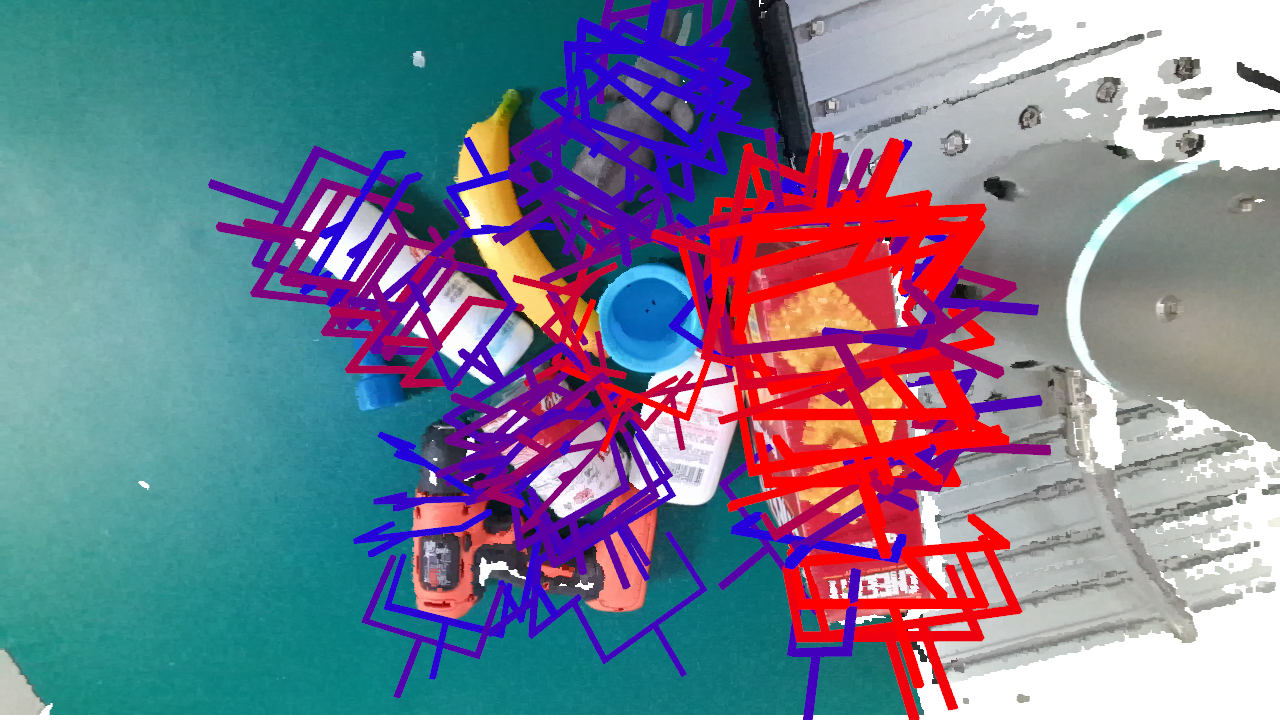Baseline model for "GraspNet-1Billion: A Large-Scale Benchmark for General Object Grasping" (CVPR 2020).
- Python 3
- PyTorch 1.6
- Open3d >=0.8
- TensorBoard 2.3
- NumPy
- SciPy
- Pillow
- tqdm
Get the code.
git clone https://github.com/graspnet/graspnet-baseline.git
cd graspnet-baselineInstall packages via Pip.
pip install -r requirements.txtCompile and install pointnet2 operators (code adapted from votenet).
cd pointnet2
python setup.py installCompile and install knn operator (code adapted from pytorch_knn_cuda).
cd knn
python setup.py installInstall graspnetAPI for evaluation.
git clone https://github.com/graspnet/graspnetAPI.git
cd graspnetAPI
pip install .Tolerance labels are not included in the original dataset, and need additional generation. Make sure you have downloaded the orginal dataset from GraspNet. The generation code is in dataset/generate_tolerance_label.py. You can simply generate tolerance label by running the script: (--dataset_root and --num_workers should be specified according to your settings)
cd dataset
sh command_generate_tolerance_label.shOr you can download the tolerance labels from Google Drive/Baidu Pan and run:
mv tolerance.tar dataset/
cd dataset
tar -xvf tolerance.tarTraining examples are shown in command_train.sh. --dataset_root, --camera and --log_dir should be specified according to your settings. You can use TensorBoard to visualize training process.
Testing examples are shown in command_test.sh, which contains inference and result evaluation. --dataset_root, --camera, --checkpoint_path and --dump_dir should be specified according to your settings. Set --collision_thresh to -1 for fast inference.
The pretrained weights can be downloaded from:
checkpoint-rs.tar[Google Drive] [Baidu Pan]checkpoint-kn.tar[Google Drive] [Baidu Pan]
checkpoint-rs.tar and checkpoint-kn.tar are trained using RealSense data and Kinect data respectively.
A demo program is provided for grasp detection and visualization using RGB-D images. You can refer to command_demo.sh to run the program. --checkpoint_path should be specified according to your settings (make sure you have downloaded the pretrained weights). The output should be similar to the following example:
Try your own data by modifying get_and_process_data() in demo.py. Refer to doc/example_data/ for data preparation. RGB-D images and camera intrinsics are required for inference. factor_depth stands for the scale for depth value to be transformed into meters. You can also add a workspace mask for denser output.
Results "In repo" report the model performance with single-view collision detection as post-processing. In evaluation we set --collision_thresh to 0.01.
Evaluation results on RealSense camera:
| Seen | Similar | Novel | |||||||
|---|---|---|---|---|---|---|---|---|---|
| AP | AP0.8 | AP0.4 | AP | AP0.8 | AP0.4 | AP | AP0.8 | AP0.4 | |
| In paper | 27.56 | 33.43 | 16.95 | 26.11 | 34.18 | 14.23 | 10.55 | 11.25 | 3.98 |
| In repo | 47.47 | 55.90 | 41.33 | 42.27 | 51.01 | 35.40 | 16.61 | 20.84 | 8.30 |
Evaluation results on Kinect camera:
| Seen | Similar | Novel | |||||||
|---|---|---|---|---|---|---|---|---|---|
| AP | AP0.8 | AP0.4 | AP | AP0.8 | AP0.4 | AP | AP0.8 | AP0.4 | |
| In paper | 29.88 | 36.19 | 19.31 | 27.84 | 33.19 | 16.62 | 11.51 | 12.92 | 3.56 |
| In repo | 42.02 | 49.91 | 35.34 | 37.35 | 44.82 | 30.40 | 12.17 | 15.17 | 5.51 |
Please cite our paper in your publications if it helps your research:
@inproceedings{fang2020graspnet,
title={GraspNet-1Billion: A Large-Scale Benchmark for General Object Grasping},
author={Fang, Hao-Shu and Wang, Chenxi and Gou, Minghao and Lu, Cewu},
booktitle={Proceedings of the IEEE/CVF Conference on Computer Vision and Pattern Recognition(CVPR)},
pages={11444--11453},
year={2020}
}
All data, labels, code and models belong to the graspnet team, MVIG, SJTU and are freely available for free non-commercial use, and may be redistributed under these conditions. For commercial queries, please drop an email at fhaoshu at gmail_dot_com and cc lucewu at sjtu.edu.cn .




